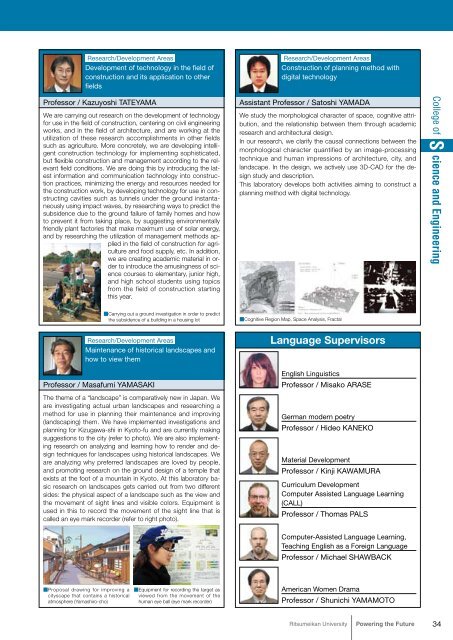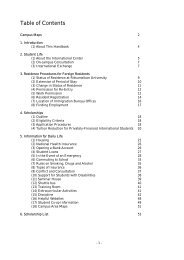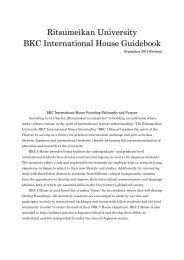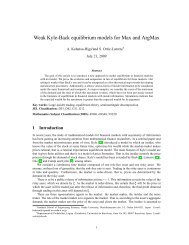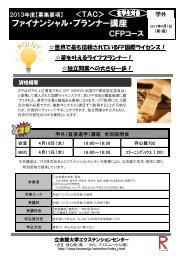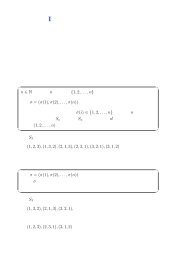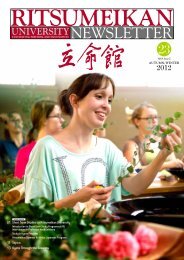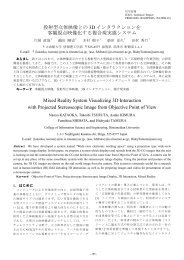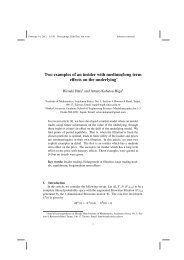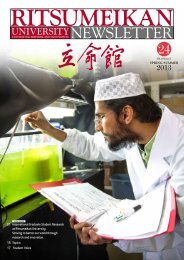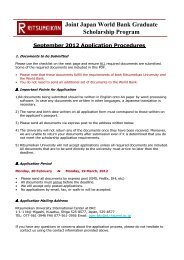Powering the Future - 立命館大学
Powering the Future - 立命館大学
Powering the Future - 立命館大学
Create successful ePaper yourself
Turn your PDF publications into a flip-book with our unique Google optimized e-Paper software.
Research/Development Areas<br />
Development of technology in <strong>the</strong> field of<br />
construction and its application to o<strong>the</strong>r<br />
fields<br />
Research/Development Areas<br />
Construction of planning method with<br />
digital technology<br />
Professor / Kazuyoshi TATEYAMA<br />
We are carrying out research on <strong>the</strong> development of technology<br />
for use in <strong>the</strong> field of construction, centering on civil engineering<br />
works, and in <strong>the</strong> field of architecture, and are working at <strong>the</strong><br />
utilization of <strong>the</strong>se research accomplishments in o<strong>the</strong>r fields<br />
such as agriculture. More concretely, we are developing intelligent<br />
construction technology for implementing sophisticated,<br />
but flexible construction and management according to <strong>the</strong> relevant<br />
field conditions. We are doing this by introducing <strong>the</strong> latest<br />
information and communication technology into construction<br />
practices, minimizing <strong>the</strong> energy and resources needed for<br />
<strong>the</strong> construction work, by developing technology for use in constructing<br />
cavities such as tunnels under <strong>the</strong> ground instantaneously<br />
using impact waves, by researching ways to predict <strong>the</strong><br />
subsidence due to <strong>the</strong> ground failure of family homes and how<br />
to prevent it from taking place, by suggesting environmentally<br />
friendly plant factories that make maximum use of solar energy,<br />
and by researching <strong>the</strong> utilization of management methods applied<br />
in <strong>the</strong> field of construction for agriculture<br />
and food supply, etc. In addition,<br />
we are creating academic material in order<br />
to introduce <strong>the</strong> amusingness of science<br />
courses to elementary, junior high,<br />
and high school students using topics<br />
from <strong>the</strong> field of construction starting<br />
this year.<br />
Assistant Professor / Satoshi YAMADA<br />
We study <strong>the</strong> morphological character of space, cognitive attribution,<br />
and <strong>the</strong> relationship between <strong>the</strong>m through academic<br />
research and architectural design.<br />
In our research, we clarify <strong>the</strong> causal connections between <strong>the</strong><br />
morphological character quantified by an image-processing<br />
technique and human impressions of architecture, city, and<br />
landscape. In <strong>the</strong> design, we actively use 3D-CAD for <strong>the</strong> design<br />
study and description.<br />
This laboratory develops both activities aiming to construct a<br />
planning method with digital technology.<br />
College of S cience and Engineering<br />
■Carrying out a ground investigation in order to predict<br />
<strong>the</strong> subsidence of a building in a housing lot<br />
■Cognitive Region Map, Space Analysis, Fractal<br />
Research/Development Areas<br />
Maintenance of historical landscapes and<br />
how to view <strong>the</strong>m<br />
Professor / Masafumi YAMASAKI<br />
The <strong>the</strong>me of a “landscape” is comparatively new in Japan. We<br />
are investigating actual urban landscapes and researching a<br />
method for use in planning <strong>the</strong>ir maintenance and improving<br />
(landscaping) <strong>the</strong>m. We have implemented investigations and<br />
planning for Kizugawa-shi in Kyoto-fu and are currently making<br />
suggestions to <strong>the</strong> city (refer to photo). We are also implementing<br />
research on analyzing and learning how to render and design<br />
techniques for landscapes using historical landscapes. We<br />
are analyzing why preferred landscapes are loved by people,<br />
and promoting research on <strong>the</strong> ground design of a temple that<br />
exists at <strong>the</strong> foot of a mountain in Kyoto. At this laboratory basic<br />
research on landscapes gets carried out from two different<br />
sides: <strong>the</strong> physical aspect of a landscape such as <strong>the</strong> view and<br />
<strong>the</strong> movement of sight lines and visible colors. Equipment is<br />
used in this to record <strong>the</strong> movement of <strong>the</strong> sight line that is<br />
called an eye mark recorder (refer to right photo).<br />
Language Supervisors<br />
English Linguistics<br />
Professor / Misako ARASE<br />
German modern poetry<br />
Professor / Hideo KANEKO<br />
Material Development<br />
Professor / Kinji KAWAMURA<br />
Curriculum Development<br />
Computer Assisted Language Learning<br />
(CALL)<br />
Professor / Thomas PALS<br />
Computer-Assisted Language Learning,<br />
Teaching English as a Foreign Language<br />
Professor / Michael SHAWBACK<br />
■Proposal drawing for improving a<br />
cityscape that contains a historical<br />
atmosphere (Yamashiro-cho)<br />
■Equipment for recording <strong>the</strong> target as<br />
viewed from <strong>the</strong> movement of <strong>the</strong><br />
human eye ball (eye mark recorder)<br />
American Women Drama<br />
Professor / Shunichi YAMAMOTO<br />
Ritsumeikan University<br />
<strong>Powering</strong> <strong>the</strong> <strong>Future</strong><br />
34


